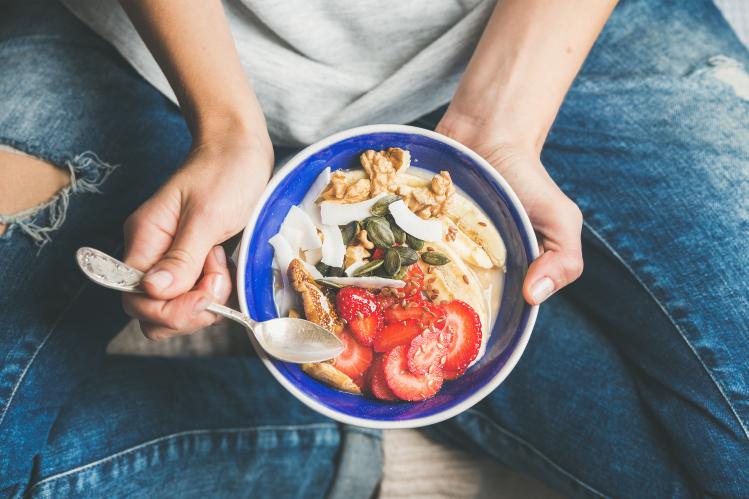Here are my favorite practical tips for eating healthy:
Drink Up- Water, that is. Coffee, tea, juice, and soda don’t count. Drink water regularly, even if you aren’t thirsty. And if you don’t like the taste, squeeze some lemon (or lime) into it.
You Can’t Eat What You Can’t See- Go on a junk hunt by reading the nutrition labels of everything in your kitchen and tossing out everything that isn’t healthy or will beckon you to indulge.
If It’s White Don’t Take a Bite- Cut all “white foods” out of your diet. Those include white bread, white pasta, white sugar, white flour, white rice, and white potatoes. Replace them with whole grain foods.
To Satisfy a Snack Attack- Try unbuttered, unsalted popcorn (Make sure it’s air popped); raw (not salted or candied) almonds; or a piece (not the whole bar, mind unsaturated fats and high in antioxidants. Your refrigerator should also contain probiotic yogurt and organic apples, and pears. A frozen banana dipped in dark chocolate with a few chopped almonds sprinkled over the make makes a great treat.
Read Labels- When you shop, be sure to check all labels for chemical additives. Basic rule: If you can’t pronounce it, don’t buy it! (one exception: quinoa.) Registered dietician Rachel K. Johnson, a professor at the University of Vermont and spokesperson for the American Heart Association, suggests looking for whole grains as the first ingredient. Be aware of the amount of saturated fat and sodium in what you buy. “Sodium intake should be kept at 1,500 mg– about two-thirds of a teaspoon of salt- and saturated fats should only be 7 percent of your daily calorie intake.
Stay Away from Sodas- Keep sugary drinks- including sodas, energy and fruit drinks, sweetened iced teas and lemonade- off your shopping list. Diet soda is no better than regular. The chemicals in them actually trigger your sweet tooth, which can make you want more.
Take It Easy- You don’t have to jump right into a diet full of legumes, flaxseed, goat yogurt, and broccoli sprouts. Always include the foods you like; otherwise, you will never stay on the program. Have fun with it. For example, try a new color fruit or vegetable each day or week.
Organic Is Generally Better- However, if everything organic is too expensive, simply pick one or two things that you like to eat in quantity and buy those organic especially dairy products, apples, celery, tomatoes, cucumbers, and berries. One of the hallmarks of organic food is the lack of pesticides, and most of these are sprayed on the outside of fruit and vegetables.
One Small Step- For a start, just make one small change a day. For example, substitute a slice of whole grain bread for white. If you want pizza try a vegetable topping.
Eat Like an Athlete- Do what all the superstar athletes do- start your day with a good, healthy breakfast that includes protein, carbohydrates, and fiver. For example an omelet with one egg yolk and two whites, and a slice of whole grain toast. Furthermore, a new study published in the Nutritional journal found that eating a bowl of oatmeal helps you feel full longer and may reduce the likeliness time is an issue, whip up a quick smoothie with yogurt, a banana, frozen fruit, chocolate protein, powder, natural almond butter, and ice.
Eat Local- “There are many good reasons to eat locally produced foods; the first among them is that t they’re very good for us,” says interventional cardiologist and professional chef Michael S. Fenster, M.D., author of Eating Well, Living Better. “There’s a direct relationship between our environment, our genetics, and our health eating locally grown foods gives us our most nutritious meals, most flavorful meals.”
Keep a Record of Your Progress- By doing so, you can commit on paper and then confront what you see or do. Also, write positive affirmations and prominently place them where they will motivate you- your bathroom mirror, the scale, the refrigerator or closet door.
For more great information on becoming Better Than Before, visit Jane Wilkens Michael

